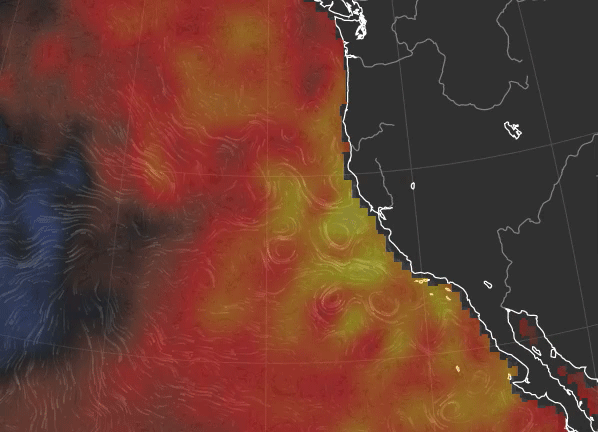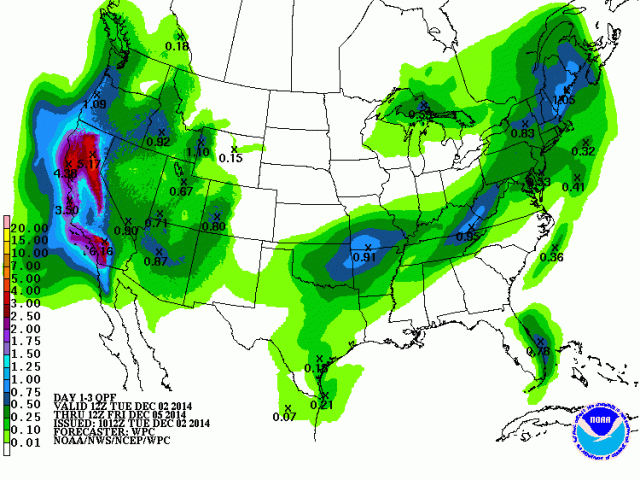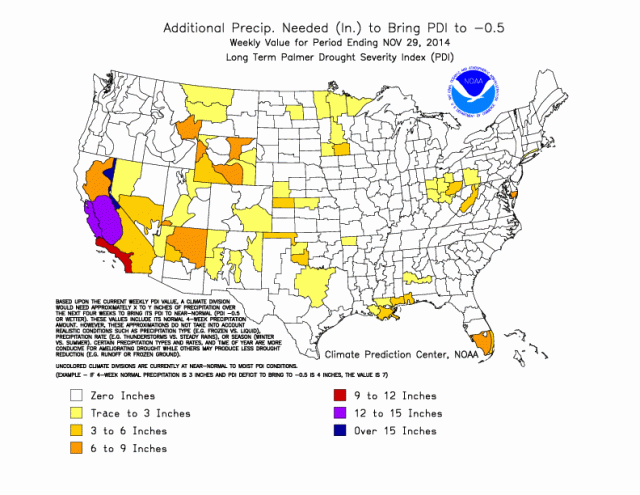News•December 2, 2014
Atmospheric River, Heavy Rain Roar Into California

By Brian Kahn
For the second time in a week, heavy rain is making an appearance in drought-weary California. This round comes courtesy of the tropics via an appropriately named “atmospheric river” that is sending precipitation across the state, bringing a modicum of relief.
Satellite animation showing precipitable water.
Credit: CIMSS

While the storm may marginally help the state-wide drought, relief could come at a high price. Heavy rain falling on dried and burned slopes could produce mudslides and flash floods, with a number of such warnings already in place.
In addition to the atmospheric river, near record-warm ocean waters off of California’s coast will also provide the storm with more liquid fuel as precipitation spreads from south to north across the state.
Sea surface temperature anomalies, which are up to 4.3°F above normal off California's coast.
Credit: Earth

National Weather Service Hanford office meteorologist Gary Sanger said the valleys could receive up to an inch of rain. And in the foothills, 2-3 inches of rain is likely with locally higher amounts up to 5 inches not out of the question by Wednesday evening.
The tropical nature of the storm is keeping snow levels high in the Sierra Nevada mountains, although they’ll eventually lower and snowfall totals are expected to be around 2-3 feet. The region has seen anemic snowfall this year, with a snowpack just below 25 percent of average.
Precipitation forecast through Friday morning.
Credit: NOAA

A similar story is likely to play out in the northern half of the state as the storm drifts that way throughout Tuesday and Wednesday. That region received an inch or more of precipitation from a storm this past weekend and is currently home to the state’s only sliver of drought-free land.
Otherwise, nearly the entire state is in drought, with more than half in exceptional drought, the worst category used by the U.S. Drought Monitor. Some research has tied climate change to the long-lasting ridge of high pressure that’s been the main meteorological driver of California’s drought and record warm year, though there’s still ongoing research on the exact connection.
“It’s not going to ease the drought because we are so far behind after 3 years of drought. An inch or two of rain is not going to ease (it),” Sanger said.
Total precipitation needed to end drought conditions.
Credit: NOAA

According to recent data from the National Oceanic and Atmospheric Administration, parts of southern California need 9-12 inches of precipitation to make a marked improvement in the drought. Inland areas would need 12-15 inches while the northern Sierra Nevada will need more than 15 inches of precipitation to shake one of the worst droughts on record.
You May Also Like:
What’s At Stake in Lima Climate Talks
Clues Show How Green Electricity May Be in 2050
Climate Investments ‘Falling Short’ of 2°C Goal
Report Maps Out Decarbonization Plan for U.S.
Here’s How the U.S. Can Adapt to Climate Change